
A panoramic view of the sanctuary. Taken from the watchtower, the photo depicts about one-fifth of the Bhindawas Wetlands. More images from the region at Flickr
The tropical and northern-dry deciduous forest belt of Haryana is exceptionally rich in birdlife. A substantial chunk of the bird species found in the entire state along with Delhi region could be spotted here in this semi-desert sandy plain area. Leave aside the Sal-forest belt, the second best region for organised birding in the state would be this. Not only Bhindawas but another bird-sanctuary Khapadwas, situated adjacently at a distance of 1.5 km, along with a drain that tangentially passes through it, makes the area an ideal birding destination during winter-migration season.
As is confirmed by the game records of the previous rulers of Jhajjar, in its heydays, the region was equally famous for sheltering a wide variety of animals including tigers. The onetime nawab of Jhajjar, Nawab Ghulam Ali Khan, is often portrayed riding on a tiger. 1845-1850. Collection: Cynthia Hazen Polsky, New York. Due to its close proximity with the territory of Delhi, the region continued to be frequented by the Mughals and later the British for their game trophies. However, courtesy the avaricious materialistic growth later and the shrinking habitat, today, animals are no longer sighted and birdlife too has been dwindling.

Nawab Ghulam Ali Khan of Jhajjar is often portrayed riding on a tiger. 1845-1850. Collection: Cynthia Hazen Polsky, New York. *Source: Tehelka
Apart from supporting a wide variety of resident birds, the wetland has long been attracting avian visitors from far and wide. From just a water-logged territory to its fortunate transformation into a full-fledged bird sanctuary, the wetland has equally been frequented by bird enthusiasts. The forest officials would smugly endorse that the birding-site was first discovered by a group of “foreigners” who later advocated setting up of a well-conserved bird sanctuary. During the pre-independence days, Bhindawas benefitted from its location on the tail-end of the drain which fed the wetland with monsoon excesses it carried.

Locally called Desi Punkowa, an Indian Cormorant drying its wings. [@satravell is @gobNomadic now]. More bird images from the region at Flickr

Perched atop a Eucalyptus Tree, a group of Great Cormorants taking the sun. More images at Flickr Photoset

Count your species. This site is favourite with waterfowls. More images at Flickr Photoset
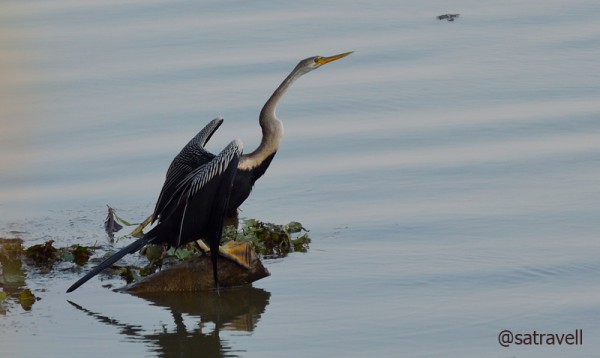
Locally called Pandubi, the Darter is also called Snakebird. [@satravell is @gobNomadic now]. More bird-images from the region at Flickr Photoset

Locally called Gangla, the less common Asian Openbill. More bird-images from the region at Flickr Photoset
Later on as luck would have it, an occasional power failure at the lift system of the nearby Jawaharlal Nehru feeder would often divert the flow of water creating an artificial lake that not only acted as the buffer storage but fed the habitat of a wide variety of water fowls as well as a few wild mammals. Meanwhile, the site was declared as a wildlife sanctuary by the state government in 1985, whereas, the union government’s nod to set it up as a bird sanctuary came as recently as in 2009. Originally constructed to store the excess water of the canal, the 12 km long peripheral embankment, fenced by nothing but eucalyptuses, now doubles as a pathway-cum-motorway and facilitates bird-watching.

Locally called Desi Neelkanth, an Indian Roller. [@satravell is @gobNomadic now]. More bird-images from the region at Flickr Photoset

The ready-to-harvest fields along the boundary of the lake. The pathway-cum-motorway is to the right
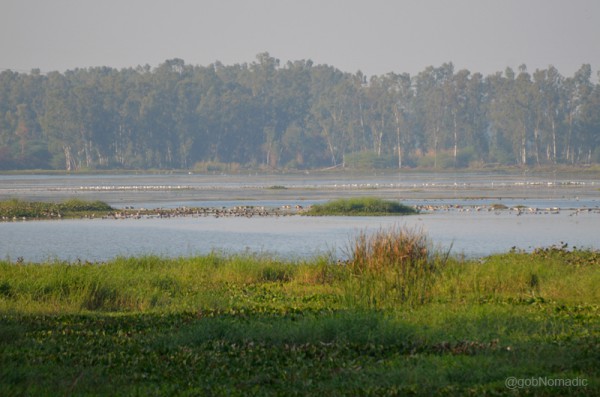
A portion of the sanctuary as observed from a watchtower. More images from the region at Flickr Photoset
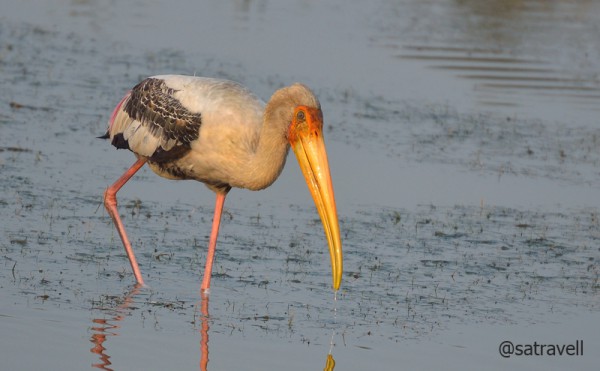
Locally called Janghil, a Painted Stork. More bird-images from the region at Flickr Photoset
The spread of the sanctuary – almost 1100 acres – is effectively similar to the Bharatpur wetlands and more than double the area of the Sultanpur National Park. The official checklist of the state forest department mentions up to 250 avian species inside the Sanctuary. Enlarge your scope to include the neighbouring habitats such as villages of Khapadwas, Khetawas, Dhighal and Matanhail bani, etc. and your actual field-result could be more than that. With some on-site patience and luck, you could actually spot a few rare creatures.
Tucked away from the humdrum of town-life, the peaceful environs of the sanctuary would make for an ideal birding destination. A network of unmarked trails within the embankment would take you closer to the avian creatures in their habitat as well as heronries of waterfowls. While picnicking, lay your lunch out in one of the two watchtowers and enjoy the expansive view of the lake. My preferred lounging site within the lake is the olden bridge next to the drain where you could closely observe families of playful parakeets.
Every year the lake attracts a fairly good number of waterfowls. An overall annual headcount could be pegged at 50,000. Some of the commonly spotted resident and migratory birds include Blue Peafowl, Yellow-crowned Woodpecker, Cormorants, White-throated Kingfisher, Gray Francolin, Black Francolin, Shikra, Black Kite, Oriental Honey Buzzard, Comb Duck, Eurasian Thick-knee, Bronze-winged Jacana, Purple Swamphen, Spotted Owlet, Spot-billed Duck, Greater Coucal, Little Grebe, Flamebacks, Coppersmith Barbet, Indian Roller, Common Hoopoe, Eurasian Collared Dove, Black Drongo, Rock Pigeon, Laughing Dove, Jungle Babbler, Oriental Darter and Rose-ringed Parakeet, Whiskered Tern, Greater Flamingo, Osprey, Eurasian Marsh Harrier, Gulls, Graylag Goose, Mallard, Ruddy Shelduck, Gadwall, Eurasian Wigeon, Common Teal, Northern Pintail, Northern Shoveler, Pratincoles, Green Bee-eater, Cuckoos, Common Pochard, Great Egret, Crested Lark, Ashy Prinia, Bitterns, Plovers, Lapwings and Bar-headed Goose, etc. Besides, one can also find mammals such as Neelgai, Jungle Cat or Jackals within the sanctuary.

Locally called Ablak Jhaari-pidda, a Pied Bushchat. More bird-images at Flickr Photoset

Locally called Dawak, a White-breasted Waterhen. More bird-images at Flickr Photoset

Locally called Thar-Thar Kampini or Dauma, a Brown Rock-chat. More bird-images at Flickr Photoset

Locally called Safed Giddh, an endangered Egyptian Vulture. [@satravell is @gobNomadic now]. More bird-images at Flickr Photoset
While at Bhindawas, if you are lucky you might bump into its most regular visitor, Sh Suresh C Sharma. Right from its notification, Sh Sharma has contributed considerably to ensure Bhindawas gained recognition and knows the lake like the back of his hand. I have had the luxury of accompanying him on quite a few of his field visits. Still young at heart, Sh Sharma is quite knowledgeable about the area and keeps a track of bird activities at the lake.

Sh Suresh C Sharma has contributed appreciably to ensure Bhindawas gained recognition

A pair of Blue Bulls (Neelgai), Asia’s largest antelope, at Bhindawas. More from the region at Flickr Photoset
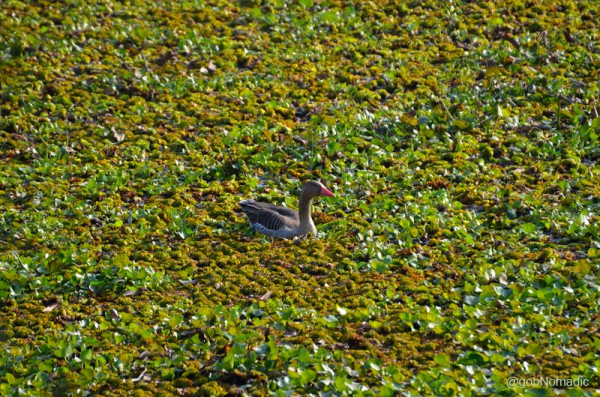
A Greylag Goose wading through Water Hyacinth, the biggest threat to the emerging habitat. More at Flickr

A near-threatened Indian Roofed Turtle sunbathing at the lake. More images from the region at Flickr Photoset

Locally called Kinai, a near-threatened River Tern. More bird-images from the region at Flickr
With acres of yellow mustard fields spread across all directions, the surroundings of the lake in winters are equally enticing. Located within the confines of the newly carved district of Jhajjar, the Bhindawas Bird Sanctuary is approximately 15 km from the main town and is not more than a couple of hours drive from Gurgaon. If traveling from Delhi or Gurgaon, the lake could either be reached through a left-diversion at village Chuchhakwas on the Jhajjar – Dadri highway or from the right-diversion at village Hassanpur on the Jhajjar – Kosli highway. Approaching from Rohtak, take the diversion towards village Chuchhakwas, via Beri, through village Dhighal on the Rohtak – Jhajjar highway.
Even as the state tourism department is mulling to build a resort here, as of now, a limited accommodation is available with the state forest department in its rest house. If booked in advance, the resident cook can dish out superb home-cooked meals. The winter timings are 0630 – 1700hrs and in summer from 0600 – 1800hrs. Carry a pair of binoculars and a telephoto if you must.

Locally called Sarbo Baya, a Black-breasted Weaver pair. [@satravell is @gobNomadic now]
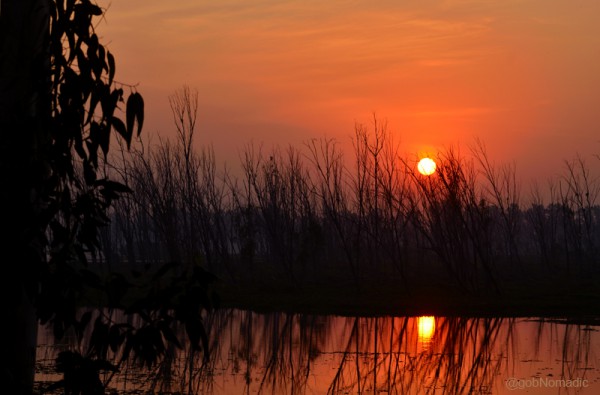
Sun down at Bhindawas. More images from the region at Flickr Photoset
Average Altitude: 220 m
Best time to visit: Winter season
Travel Lure: Bird watching
Accommodation: Very Limited
 bNomadic
bNomadic


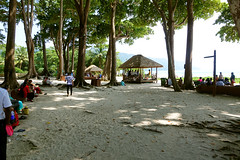






Wow… great bird watching! Very interesting post. All the images are nice…but the last two are the best 🙂
Thanks admin. 🙂 Keep visiting bNomadic. I’ll soon upload more pics from the region.
Lovely post. Specially like the fact that you’ve mentioned the local names too. My favorite – the neelkanth. So, did you go birding with an expert or you’re one yourself?
Thanks Vibha. It will be of interest to notice the local names. Insofar as bNomadic is concerned, I am a one man army. Most of my best birdwatching moments happened when I was alone.
That’s one strong one man army! 🙂
Amazing photographs and very interesting information. Thanks!
Thanks for stopping by my blog admin. Keep visiting for more. 🙂
Magnificent avian captures!
Thanks Niranjan for appreciating the efforts. Keep visiting bNomadic 🙂
Nice Place..
i am living in Gurgaon since 7 years. i never know that such a beautiful place is so near to me.
thanks for introducing it to me.
O yes. It is. Even the aravali hills belt is full of hidden attractions. Thanks for dropping by my blog. Hope you’d want to visit again. 🙂
Wonderful shots!! The turtle shot- EPIC!
Thanks. Keep visiting bNomadic for more. 🙂
Sure 🙂
Looks beautiful!
Thanks for stopping by bNomadic. Keep visiting 🙂
Wow!! Awesome….
Thanks. Keep visiting.
Excellent photographs and information about these birds! Now I know where to go when I want to look up names of birds that I might have spotted during my travels in India! Keep up the good work and wish you a great year ahead!
Absolutely true! Thanks for visiting bNomadic. Keep visiting for more travel stories from India. 🙂
Wonderful Place wonderfull Photos!
Thanks for dropping by my blog admin. Keep visiting bNomadic for more. 🙂
Wow great to read a subject specific about haryana
Thanks admin for stopping by my blog. Keep visiting bNomadic for more. 🙂
Wow Great pictures!
Mark and Cindy
s/v Cream Puff
Thanks. Keep visiting bNomadic 🙂
Amazing pictures. Great post.
Thanks admin. Keep visiting bNomadic for more.:-)
Some interesting and close captures….specially the Desi Punkowa, an Indian Cormorant drying its wings and Janghil, lovely orange beak and the magnificent River Tern.
Thanks Vandana. Those surely are nice creatures. It is all the more fun to observe them from close quarters. Keep visiting bNomadic for more.
terrific blog you have here! absolutely envious of your travels 🙂
Thanka Jayanth for stopping by my blog. Keep visiting for more 🙂
Lovely birds! Very nice photography!
Thanks admin for dropping by bNomadic. More of this series soon…
Wow!! I really didn’t know Haryana could be this interesting… Awesome pictures!
O yes! More escapades from Haryana soon. Keep visiting bNomadic for more 🙂
Gorgeous bird photos you have there. Keep up the great work. 🙂
thanks for dropping by my blog. Keep visiting bNomadic for more 🙂
I really enjoyed reading this – birds are a very liberating creature in some ways. At home, each morning the birds fly in (we are one of the few houses in our area that has kept the trees) and it is very calming to hear their chatter and watch them glide in and out of the branches. Sometime I can even forget that I’m in the middle of the city. Love these photos
Fortunately or not that is the best option to observe or support birdlife we are left with on this planet. Especially in city-like environs in such testing times. Kudos!
Awesome! Thank you. Thank you. Thank you. Did I say Thank You. Thank you for sharing these great photos and information. My wife and I went to Bharatpur in 2004 and loved it! We saw a Scopse Owl, which was pretty cool and a heap of other birds to numerous to mention. Would love to go back there too!
Thanks for stopping by my blog. And for showering it with appreciation. Keep visiting for more. ☺
thank u guys ! will join u soon !
Great! Keep visiting bNomadic